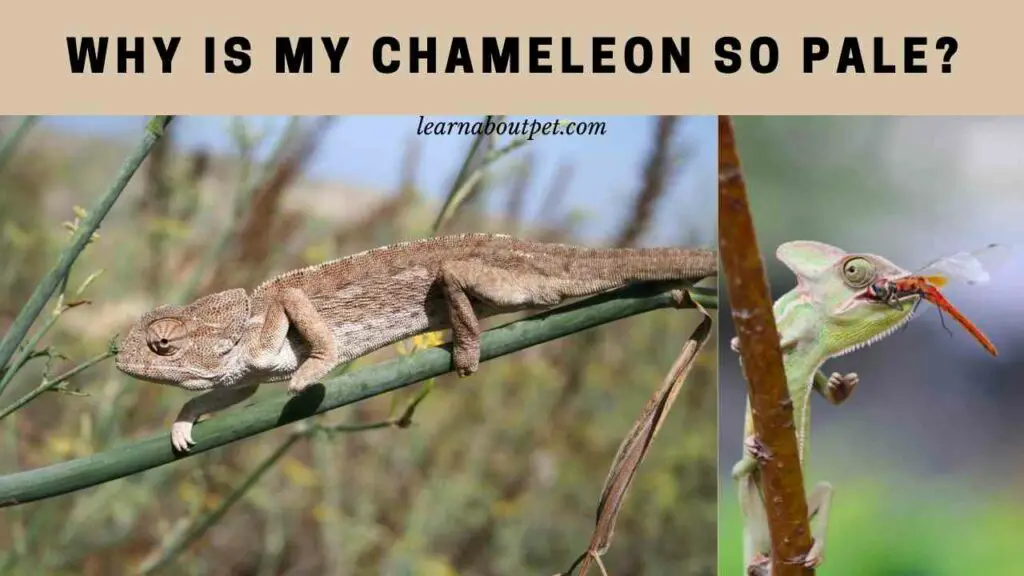The realization that your chameleon has become extremely pale can cause you a great deal of concern. You will want to know why the chameleon has become so pale, whether it is normal, and if there is anything you can do to help. Read on, to find answers to all those questions.
Why is my chameleon so pale? Often, paleness in chameleons is associated with skin shedding. Chameleons do shed their skin, as part of their growth and renewal. And in readiness for the shedding, it is typical for the skin to acquire a pale or white hue. The chameleon will also decline food at this time.
Therefore the white or pale color is usually indicative of skin loosening for shedding. The shedding process can take between several hours to a whole day.

There are also cases where the paleness is a sign of poor conditions in the enclosure. For instance, if the temperature is too high, the chameleon’s skin may become pale. This they do as they try to reflect off the excess heat. There are also situations where the paleness (when accompanied by other signs) indicates that the chameleon may be sick.
Why Is My Chameleon So Pale?
Normally, the people who pose the question on why is my chameleon so pale are advised to first consider the possibility of it being part of the routine skin shedding process. Consequently, the person asking why is my chameleon pale will normally be asked when was the last time the chameleon shed skin? If it was long ago, and the chameleon is due for a skin shed, then the paleness may be due to the upcoming skin shedding.
Young chameleons typically shed skin after every three to four weeks. Adult chameleons may shed after about 8 weeks (two months).
As chameleons prepare to shed, the old skin loosens. It is this loosening which accounts for the skin turning pale. This is why acquiring a pale skin color is one of the chameleon shedding signs. Normally, a chameleon that is shedding skin won’t eat. Therefore if you have a situation of chameleon shedding not eating, this would be quite normal.
The shedding process usually takes just a few hours, or a day. But there are times when the chameleon is unable to shed the skin properly. This is a possibility where, following a skin shedding incident, your chameleon has white spots which give it a pale appearance. It may not have managed to fully lose the old skin, hence the flakes.
Another possibility that the people who pose the question on why is my chameleon so pale is that of it being due to too much warmth. If the chameleon is experiencing too much warmth, it turns into a lighter (paler) color. This it does in a bid to reflect off the excess heat.
If the paleness is not due to shedding or too much warmth, it could be a sign of sickness.
Why Is My Chameleon Lighter Than Usual?
There are three key possibilities why your pet chameleon is lighter than usual.
Firstly, the chameleon may be preparing to shed his skin. Ask yourself: when was the last time he shed and what is his age?
Secondly, there may be temperature changes that have caused his enclosure to become too hot. So he turns lighter than usual to reflect off the excess heat.
Thirdly, the chameleon may be sick – possibly with a skin condition, dehydration or something else along those lines.
You need to check for other signs that the chameleon may be manifesting. Only then will you be able to figure out why he is lighter than usual. You can also use an elimination method, to rule out the various possibilities. For instance, suppose the chameleon shed skin just last week. Then his being lighter than usual is unlikely to be due to an upcoming skin shed. If the temperature conditions in his enclosure are perfect, his lightness is unlikely to be due to too much warmth…
Ultimately, an upcoming skin shed, too much warmth or illness are the main possible reasons for your chameleon becoming lighter than usual.
What Does It Mean If My Chameleon Is Pale?
Another way of asking the question on why is my chameleon so pale is where you ask, what does it mean if my chameleon is pale? And the answer is that a chameleon pale color could be showing that the chameleon is about to shed skin.
Another possible reason why your chameleon looks pale is because it is too hot. So it wants to reflect the excess heat. It is also possible that the chameleon is sick – possibly with a skin condition, dehydration and so on.
If your chameleon shed skin recently, and has remained pale ever since, it could be an indication of chameleon shedding problems. This is like where the chameleon fails to shed off the old skin. So it remains on his body. But because it is now loose, it retains the pale appearance. This may also manifest in the form of chameleon white spots on skin, or white patches.
Why Is My Chameleon So Pale And Weak?
In answering the question on why is my chameleon so pale and weak, there are two key possibilities to consider. The first possibility is that of it being a situation where the chameleon is preparing to shed skin. The second possibility is that of it being a situation where your chameleon is sick. For instance, if he is suffering from dehydration, he may become weak and pale.
Those possibilities apply if the chameleon has a white pale hue on the skin. But what if she is pale, but green? In that case, you will ask, why is my chameleon pale green? And in this case, it would probably be a mating signal. So if it is a female chameleon, a pale green skin color means that she is ready to mate. After mating, she will likely acquire a dark hue.
Then again, the paleness that indicates mating readiness is usually not accompanied by weakness. On the contrary, it is accompanied by liveliness. So if your chameleon is pale and weak, it could be more likely a sign of an illness or discomfort.
Can A Chameleon Turn White?
Yes, a chameleon can turn white. If, for instance, it is up against a white background, it will turn white (or something close to white). This it will do as part of its normal camouflage behavior. A chameleon will also tend to turn whiter when its skin loosens ready for shedding. Further, a chameleon that is too hot may turn white in a bid to reflect the heat.
On another note, a sick chameleon (for instance, one that is dehydrated or has skin problems) may turn white. There are also those who theorize that a chameleon may start turning white if it is under too much stress.
What Does It Mean When A Chameleon Turns White?
Often, the people posing the question on why is my chameleon so pale will express interest in knowing what it means when a chameleon turns white. And the commonest answer is that the chameleon may be preparing to shed skin.
If that is not a possibility (for instance, because the chameleon shed skin just the other day), then it may mean that he is under too much heat. So he turns white to reflect off the excess heat.
What if it seems to be a situation where the chameleon is acquiring a permanent white hue? It could mean that he is sick. Perhaps the issue is dehydration. Or perhaps it is a skin condition – including one where the chameleon has been unable to shed skin fully. In this scenario, where the chameleon is acquiring a permanent white hue, it may be ideal to consult a vet.
Even where you just have your chameleon white around mouth or chameleon white around nostrils, and it seems to be becoming permanent, it is good to consult a vet. It may be an indication of something that is seriously wrong with the chameleon.

Why Is My Panther Chameleon Pale?
As we said while answering the why is my chameleon so pale question, the commonest reason for chameleon turning pale is skin shedding. So if your panther chameleon is pale (and he is also refusing to eat), it may be a sign that he is about to shed skin. But there are other possibilities. Those include where the chameleon is too hot, and turns pale/lighter to reflect off the excess heat. Or where the panther chameleon is sick, and is turning pale as a result.
If your panther chameleon is only temporarily pale, it may not be cause for concern. But if you have a situation of your panther chameleon turning white on a permanent basis, then it should be cause for concern.
Why Is My Veiled Chameleon Pale?
Your veiled chameleon may be pale because it is about to shed skin. If your veiled chameleon is in an enclosure that is too hot, it may turn pale (as a cooling mechanism). Further, if your veiled chameleon has a skin condition or some other illness, it may turn pale.
Much of course also depends on the extent of the paleness. For instance, if you have a veiled chameleon pale head, that is different from a situation where the veiled chameleon’s entire body has become pale. But all in all, the main possibility is that the chameleon is about to shed. Others are that the chameleon is sick or is trying to reflect off excess heat.
Why Does My Chameleon Look Ashy?
Usually, it is a sign of an impending skin shed. But where the chameleon maintains the ashy appearance for too long, it may signify an unsuccessful skin shed. Or it may signify illness in the chameleon (perhaps a skin condition, constant dehydration or something else along those lines).
How Do I Know If My Chameleon Is Dying?
Often, the people who pose the question on why is my chameleon so pale are individuals who have worries that their chameleons may be dying.
So they wonder whether the paleness is a sign of a chameleon that is dying. But the truth of the matter is that skin paleness is rarely a sign of a chameleon that is dying. On the contrary, it is skin darkening that tends to be a sign of a chameleon that is dying.
Ultimately, signs of a dying chameleon will typically include swelling, lethargy and eyes that don’t open. Remaining the lower part of the cage is also common.
What Color Does A Chameleon Turn When It Dies?
Often, it turns black, or dark brown. So a chameleon doesn’t usually acquire a pale color when it dies (or when it is about to die). This reassurance is important to the person posing the question on why is my chameleon so pale.
That is because many such people are under the impression that the chameleon pale color shows it is dying. But really, when a chameleon is dead/dying, it usually acquires a darker (not lighter) skin hue.
How To Help A Shedding Chameleon?
As we have seen while answering the why is my chameleon so pale question, the paleness is usually in preparation for skin shedding. It means that the chameleon is about to shed skin.
This leads to the question on how to help such a shedding chameleon. And the answer is by ensuring that it is well moisturized (perhaps by misting more often). You also need to maintain good humidity conditions. This way, the chameleon will be able to shed the skin with ease.
Final Verdict – Why Is My Chameleon So Pale?
As we have seen, the reason for your chameleon being so pale may be because it is about to shed skin. It may also be because the chameleon is in a cage that is too warm, and is therefore turning pale to reflect off the excess heat. Further, the chameleon may be so pale because it is sick, for instance, because it has a skin problem or a dehydration problem.

Ultimately, where a chameleon’s paleness starts becoming permanent, it is advisable to take it to an exotic pets vet for a checkup.
It is your duty as a pet lover to explore more about your pet and keep the chameleon‘s health in top shape.

Welcome to Learn About Pet. My name is Rajkumar Ravichandran and I love all pets, travel, and amazing food. I write about my passion and personal experience caring for multiple pets in this blog! ❤️
Post Disclaimer
DISCLAIMER: THIS BLOG OR WEBSITE, "Learn About Pet", DOES NOT PROVIDE YOU WITH MEDICAL ADVICE AND IS NOT A SUBSTITUTE FOR MEDICAL ADVICE. ALWAYS GET IN TOUCH WITH YOUR PERSONAL VETERINARIAN AND USE INFORMATION HERE AS GENERAL ADVICE.
The information, including but not limited to, text, graphics, images and other material contained on this website are for informational purposes only. No material on this site is intended to be a substitute for professional veterinary advice, food recommendation, diagnosis, or treatment. Always seek the advice of your veterinarian or other qualified health care provider with any questions you may have regarding a medical condition or for pet food related questions.







